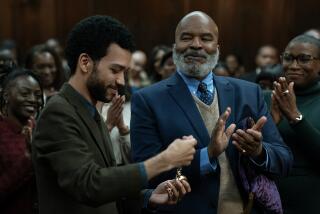‘Black Is the New White’ by Paul Mooney
Paul Mooney recalls the day he became Richard Pryor’s shadow partner. It was 1968, and the two young comics were sitting in a Hollywood greasy spoon, with Pryor nursing another hangover, so Mooney lightened the mood with an off-the-cuff, X-rated one-liner that made his buddy convulse.
Pryor copped the joke in his act. Later, he slipped a $10,000 watch onto Mooney’s wrist as a token of thanks, and so began a friendship that lasted until Pryor’s death in 2005. Pryor was a self-loathing, drug-addicted genius, Mooney an industrious teetotaler, but they bonded over laughs and a distrust of the white Hollywood power structure.
“Black Is the New White” is Mooney’s unvarnished memoir of that friendship. At a time when comedians -- even African American icons such as Bill Cosby -- never talked about race, Pryor (aided and abetted by Mooney) dared to confront the elephant in the room. Mooney, who has also written for “In Living Color” and “Chappelle’s Show,” also traces his own path from humble Deep South roots to a comedy elder statesman known for his incisive riffs on racism.
Pryor was already consuming narcotics, booze and women (his proclivities are well-documented in his 1995 autobiography, “Pryor Convictions”) when the men first met. Mooney faced a choice: avoid the madness or become Pryor’s writer, mentor, confidant and designated driver. “Even though I have a feeling that sooner or later it’s all going to crash, I still accept Richard’s friendship,” Mooney writes about the choice he made. “He is irresistible.”
And Pryor was already successful. He’d done movies, television, Vegas and had recorded a comedy album. But Pryor’s comedy was still safe and sanitized, a far cry from the profane routines and street characters for which he would later become famous. He felt like a black comic who’d sold out for white acceptance.
The early chapters of “Black Is the New White” cover Pryor’s transformation in the late 1960s, when he shunned the Sunset Strip comedy clubs for places like Redd Foxx’s Jazz Go-Go and Maverick’s Flat in South Los Angeles -- clubs that “bring in black audiences and feature the kind of comedy that nobody is ready for on the Strip.” The change was complete when Pryor assumed a street-smart, improvisational style and, most important, Mooney says, he transformed the n-word into a weapon and trained it on the status quo.
Hollywood wasn’t ready. Foxx and Norman Lear hired Pryor and Mooney as writers on “Sanford and Son,” but NBC preferred its stable of white scribes. Mel Brooks wanted Pryor to play the black sheriff (a character Pryor created) in “Blazing Saddles” but Warner Bros. vetoed the move.
The duo’s penchant for boundary-pushing made network censors nervous, and in 1977, when Pryor landed an NBC variety series (with Mooney as head writer, casting director and occasional actor), he complained of network interference and, drug-addled and fearing failure, canceled the show after four episodes.
That failure led to the crash Mooney expected all along, culminating in Pryor’s 1980 self-immolation while freebasing cocaine. Mooney believes it was no simple suicide attempt: “I’ve never seen anyone more messed up over success than Richard Pryor. For him, it’s a constant battle between success in the white world and keeping it real for his black self. . . . he loves the approval and women and celebrity, but it costs him his soul. So he lights himself on fire. He’s freebasing himself, burning off the white impurities.”
Mooney is widely respected among African American audiences and his comedy peers, though not instantly recognizable to the masses. “Black Is the New White” recounts the struggles that earned Mooney that respect, such as leading a strike against the Comedy Store in the 1970s, which ended with the club agreeing to pay up-and-coming comics (Jay Leno and David Letterman, among others) for the first time. Mooney also revisits his public renouncement of the n-word after Michael Richards’ racist outburst onstage at the Laugh Factory in 2006.
But the book’s strength is the story of two opposites who kindled one another’s creative embers -- it serves as an elegy for Pryor, a troubled savant who couldn’t quite harness his immense talents.
“When I think about Richard, I think about keeping it real,” Mooney writes. “I think about never losing my voice, never giving in, never selling out, always keeping black, always sticking to the street. Staying neighborhood and not Hollywood.”
Ryfle is writing a book about Hollywood during the civil rights era.
More to Read
Sign up for our Book Club newsletter
Get the latest news, events and more from the Los Angeles Times Book Club, and help us get L.A. reading and talking.
You may occasionally receive promotional content from the Los Angeles Times.






